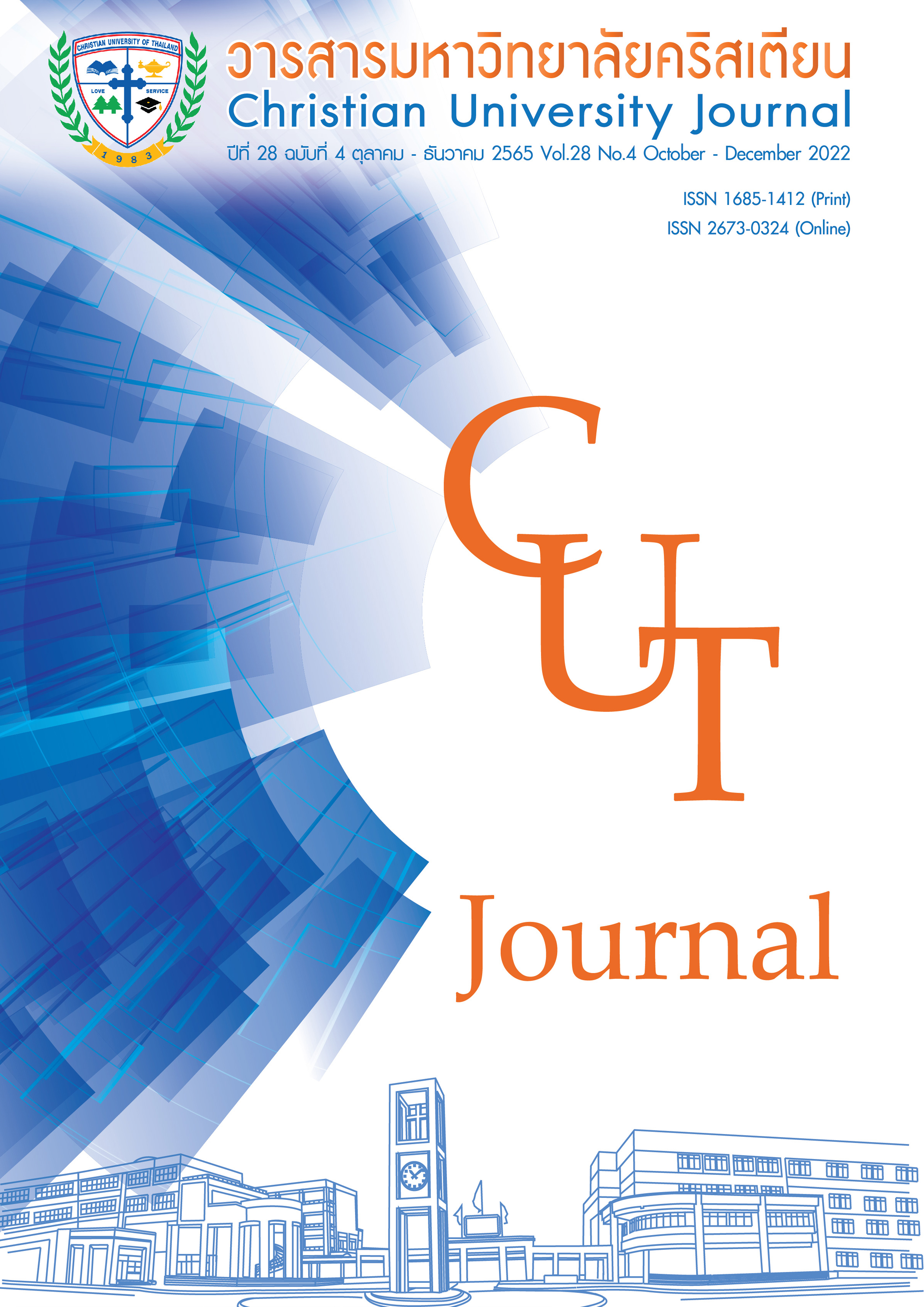ปัจจัยด้านผู้ดูแลที่มีอิทธิพลต่อภาวะโภชนาการในผู้ป่วยมะเร็งศีรษะ และคอระหว่างได้รับรังสีรักษา
คำสำคัญ:
บทบาทของผู้ดูแล, มะเร็งศีรษะและคอ, ความรอบรู้ด้านโภชนาการ, ภาวะโภชนาการ, สัมพันธภาพระหว่างผู้ดูแลกับผู้ป่วยบทคัดย่อ
การศึกษาเชิงทำนาย มีวัตถุประสงค์เพื่อศึกษาอิทธิพลของความรอบรู้ด้านโภชนาการของผู้ดูแล บทบาทของผู้ดูแล ด้านโภชนาการ และสัมพันธภาพระหว่างผู้ดูแลกับผู้ป่วยต่อภาวะโภชนาการในผู้ป่วยมะเร็งศีรษะและคอระหว่างได้รับรังสีรักษา โดยใช้กรอบแนวคิดทฤษฎีการปรับตัวของรอย กลุ่มตัวอย่างเป็นผู้ดูแลและผู้ป่วยมะเร็งศีรษะและคอที่ได้รับรังสีรักษาในโรงพยาบาลมหาวิทยาลัย 2 แห่ง จำนวน 120 ราย เลือกกลุ่มตัวอย่างตามเกณฑ์ เครื่องมือที่ใช้ในการรวบรวมข้อมูล คือ แบบบันทึกข้อมูลส่วนบุคคลของผู้ป่วยโรคมะเร็งศีรษะและคอและของผู้ดูแล แบบประเมินความรอบรู้ด้านโภชนาการของผู้ดูแล แบบสอบถามบทบาทของผู้ดูแลด้านโภชนาการ แบบวัดความสัมพันธ์ระหว่างผู้ดูแลกับผู้ป่วย และแบบประเมินภาวะโภชนาการของผู้ป่วย นำมาหาค่าดัชนีความตรงตามเนื้อหาได้ค่า CVI เท่ากับ 0.87, 0.91, 0.88 และ 0.93 ตามลำดับ และนำมาคำนวณหาความเชื่อมั่นสัมประสิทธิ์แอลฟ่าของครอนบาค ได้ค่าความเชื่อมั่นเท่ากับ 0.86, 0.89, 0.83 และ 0.71 ตามลำดับ วิเคราะห์ข้อมูลโดยสถิติเชิงพรรณนาและการวิเคราะห์ถดถอยพหุคูณ
ผลการวิจัยพบว่า ปัจจัยที่มีอิทธิพลต่อภาวะโภชนาการในผู้ป่วยคือ ความรอบรู้ด้านโภชนาการของผู้ดูแล (β = 0.13, p > 0.05) บทบาทของผู้ดูแลด้านโภชนาการ (β = -0.24, p < 0.05) และสัมพันธภาพระหว่างผู้ดูแลกับผู้ป่วย (β = 0.24, p < 0.05) โดยตัวแปรอิสระทั้ง 3 ตัว สามารถร่วมกันทำนายภาวะโภชนาการในผู้ป่วยมะเร็งศีรษะและคอได้ร้อยละ 7 อย่างมีนัยสำคัญทางสถิติ (p < 0.05) ผลการศึกษาครั้งนี้เสนอแนะพยาบาล ควรประเมินภาวะโภชนาการผู้ป่วยเป็นระยะ ๆ และนำผู้ดูแลเข้ามามีส่วนร่วมในการวางแผนดูแลปรับปรุงภาวะโภชนาการและช่วยเหลือผู้ป่วย เพื่อส่งเสริมภาวะโภชนาการผู้ป่วย
เอกสารอ้างอิง
กองสุขศึกษา กรมสนับสนุนบริการสุขภาพ กระทรวงสาธารณสุข. (2559). คู่มือประเมินความฉลาดทางสุขภาพของคนไทย อายุ 15 ปีขึ้นไป ในการปฏิบัติตามหลัก 3อ 2ส (ABCDE-Health Literacy Scale of Thai Adults). นนทบุรี: กรมสนับสนุนบริการสุขภาพ กระทรวงสาธารณสุข.
ปัญญรัตน์ ลาภวงศ์วัฒนา. (2552). เอกสารการสอนชุดวิชาอนามัยครอบครัวในงานสาธารณสุข หน่วยที่ 1-7. (พิมพ์ครั้งที่ 4). นนทบุรี: นำกังการพิมพ์.
มณฑิรา คำห่อ, นภาพร วาณิชย์กุล, สุพร ดนัยดุษฎีกุล, และกุลธร เทพมงคล. (2561). โมเดลการทำนายคุณภาพชีวิตของผู้ป่วยมะเร็งศีรษะและลำคอ หลังได้รับรังสีรักษา. วารสารพยาบาลศาสตร์, 36(2), 54-66.
รังสันต์ ไชยคำ, ลาวัลย์ รักษนาเวศ, นันทพร พิชะยะ, และจุฬาภรณ์ สุขศรีสวัสดิ์. (2561). ปัจจัยทำนายพฤติกรรมโภชนาการในผู้ป่วยมะเร็งศีรษะและลำคอโรงพยาบาลมะเร็งชลบุรี. วารสารกรมการแพทย์, 43(6), 68-73.
วารุณี มีเจริญ. (2557). ญาติผู้ดูแลผู้ป่วยมะเร็ง: การปรับตัวต่อบทบาทและการส่งเสริมคุณภาพชีวิต. รามาธิบดีพยาบาลสาร, 20(1), 10-22.
สถาบันมะเร็งแห่งชาติ. (2560). ทะเบียนมะเร็งระดับโรงพยาบาล พ.ศ. 2559. กรุงเทพฯ: กลุ่มงานเทคโนโลยีสารสนเทศ สถาบันมะเร็งแห่งชาติ.
Aupérin, A. (2020). Epidemiology of head and neck cancers: An update. Current Opinion in Oncology, 32(3), 178-186.
Bevan, J. L., & Pecchioni, L. L. (2008). Understanding the impact of family caregiver cancer literacy on patient health outcomes. Patient Education and Counseling, 71(3), 356-364.
Cha, E., Kim, K. H., Lerner, H. M., Dawkins, C. R., Bello, M. K., Umpierrez, G., et al. (2014). Health literacy, self-efficacy, food label use, and diet in young adults. American Journal of Health Behavior, 38(3), 331-339.
Citak, E., Tulek, Z., & Uzel, O. (2019). Nutritional status in patients with head and neck cancer undergoing radiotherapy: A longitudinal study. Supportive Care in Cancer, 27(1), 239-247.
Donini, L. M., Scardella, P., Piombo, L., Neri, B., Asprino, R., Proietti, A., et al. (2013). Malnutrition in elderly: Social and economic determinants. The Journal of Nutrition, Health & Aging, 17(1), 9-15.
Fingeret, M. C., Hutcheson, K. A., Jensen, K., Yuan, Y., Urbauer, D., & Lewin, J. S. (2013). Associations among speech, eating, and body image concerns for surgical patients with head and neck cancer. Head & Neck, 35(3), 354-360.
Given, B. A., Given, C. W., & Sherwood, P. R. (2012). Family and caregiver needs over the course of the cancer trajectory. The Journal of Supportive Oncology, 10(2), 57-64.
Jensen, S. B., Vissink, A., Limesand, K. H., & Reyland, M. E. (2019). Salivary gland hypofunction and xerostomia in head and neck radiation patients. JNCI Monographs, 2019(53), 95-106.
Kejkornkaew, S., Sirapo-ngam, Y., Monkong, S., Junda, T., & Wallhagen, M. I. (2016). A grounded theory study of the quality relationships between family caregivers and persons with head and neck cancer. Pacific Rim International Journal of Nursing Research, 20(2), 161-173.
Kiarie, H. M. (2010). Care givers' formal and nutrition literacy and its influence on nutritional status of pre-school children in Munyu, Thika East district, Kenya. (Master,s Thesis). Nairobi University, Kenya.
Locher, J. L., Robinson, C. O., Bailey, F. A., Carroll, W. R., Heimburger, D. C., Magnuson, J. S., et al. (2009). The contribution of social factors to undereating in older adults with cancer. The Journal of Supportive Oncology, 7(5), 168-173.
Megwalu, U. C. (2017). Health literacy in patients with head and neck cancer: An understudied issue. JAMA Otolaryngology–Head & Neck Surgery, 143(7), 645-646.
Moschopoulou, E., Hutchison, I., Bhui, K., & Korszun, A. (2018). Post-traumatic stress in head and neck cancer survivors and their partners. Supportive Care in Cancer, 26(9), 3003-3011.
National Cancer Institute. (2020). Informal Caregivers in Cancer (PDQ®) - Patient Version. Retrieved from: https://www.cancer.gov/about-cancer/coping/family-friends/family-caregivers-hp-pdq.
Oberst, M.T. (1991). Appraisal of caregiving scale (ACS-revised): Manual for use. Detroit: Wayne State University.
Ogama, N., & Suzuki, S. (2012). Adverse effects and appetite suppression associated with particle beam therapy in patients with head and neck cancer. Japan Journal of Nursing Science, 9(1), 28-37.
Pfister, D. G., Spencer, S., Adelstein, D., Adkins, D., Anzai, Y., Brizel, D. M., et al. (2020). NCCN guidelines insights: Head and neck cancers, version 2.2020. Journal of the National Comprehensive Cancer Network, 18(7), 873-898.
Roy, S. C. (2009). The Roy Adaptation Model. (3rd ed.). Upper Saddle River, NJ: Prentice Hall.
Sullivan, G. C. (1993). Towards clarification of convergent concepts: Sense of coherence, will to meaning, locus of control, learned helplessness and hardiness. Journal of Advanced Nursing, 18(11), 1772-1778.
ดาวน์โหลด
เผยแพร่แล้ว
ฉบับ
ประเภทบทความ
สัญญาอนุญาต
ลิขสิทธิ์ (c) 2022 มหาวิทยาลัยคริสเตียน

อนุญาตภายใต้เงื่อนไข Creative Commons Attribution-NonCommercial-NoDerivatives 4.0 International License.



